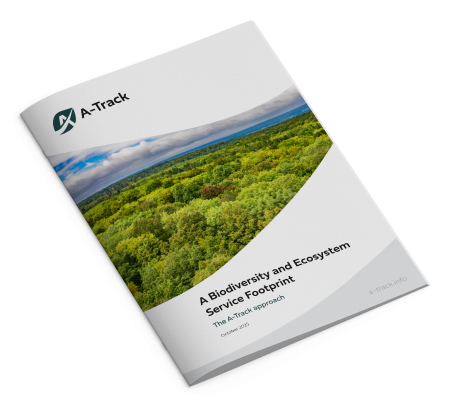
Resource description:
This report outlines the A-Track approach to the development of a Biodiversity and Ecosystem Services Footprint (BES Footprint) for products and organisations.
The report also investigates the complementarity between Life Cycle Assessment (LCA) and natural capital accounting (NCA), identifying how combining both approaches can help address current methodological and data gaps in biodiversity and ecosystem services assessment in LCA. The report is mainly addressed to LCA practitioners and researchers in business and academia looking to integrate biodiversity (and nature more broadly) in LCA for improved decision making, towards better aligning business operations and supply chains with nature positive outcomes.
The BES Footprint provides a consistent calculation framework that builds on LCA and the System of Environmental Economic Accounting (SEEA) - Ecosystem Accounting (EA) (SEEA EA) to assess the impact of products and organisations on biodiversity and ecosystem services. It includes two key components: the Biodiversity Footprint and the Ecosystem Service Footprint. Each of these components is composed of various suggested indicators that can be calculated following existing methods and models. The suggested indicators may be improved or amended if further and/or improved indicators become available.
The proposed impact assessment structure for biodiversity and ecosystem services includes:
Biodiversity Footprint, including as a minimum a measure of:
- habitat destruction/degradation (land use, land use change and water scarcity)
- pollution (acidification, eutrophication and ecotoxicity)
- climate change (global warming potential); and optionally including other pressures such as: o overexploitation
- invasive species.
Ecosystem Services Footprint, including at least:
- regulating services (soil condition)
- regulating services (water availability and condition)
- provisioning services (resource condition)
and optionally also including other ecosystem services such as:
- regulating services (pollination)
- regulating services (habitat quality)
- provisioning services (energy).
The BES Footprint aims to support comprehensive assessments (i.e. full BES Footprint/Level 3) as well as simplified approaches (i.e. screening BES Footprint/Level 1) and partial assessment (i.e. partial BES footprint/Level 2), allowing the scope of assessment to be adapted to various decision contexts and needs. These applications will need to be complemented through further practical guidelines.
A framework for the BES Footprint is outlined in detail in this report in relation to the phases of an LCA (goal and scope definition; inventory; impact assessment; and interpretation) as defined in ISO 14040. Each phase is accompanied by a practical example based on avocados as a product, with indications of where natural capital-related information based on the SEEA EA principles can play a part. By emphasising these commonalities between LCA and NCA, we demonstrate theoretically the potential for effective integration of these two approaches for the development of the BES Footprint.
The BES Footprint framework proposed in this report will be complemented by further methodological guidance and specifications to support demonstration of the BES Footprint through six A-Track case studies and to support wider application of the BES Footprint.
The BES Footprint framework will be further operationalised in the forthcoming Deliverable D3.2, which will expand on methodological issues such as data and software/digital tools requirements and availability, and interpretation, reporting, verifiability and communication of results. D3.2 will also reflect feedback from stakeholders on the BES Footprint framework proposed in this report.
The content of this (and subsequent) reports will be adapted by A-Track for training and dissemination purposes, to support business uptake of the resulting BES Footprint for products and organisations.
Author/Contact:
Isasa, M., Hong, S-H., Stauffert, S., Horn, R., Geß, A., Bianchi, M., Ugarte, R., Whitaker, D., Bedford, J., Duke, G.
DOI reference:
Suggested citation:
Isasa, M., Hong, S-H., Stauffert, S., Horn, R., Geß, A., Bianchi, M., Ugarte, R., Whitaker, D., Bedford, J., Duke, G., 2025. A Biodiversity and Ecosystem Services Footprint. The A- Track approach. A-Track Deliverable 3.1